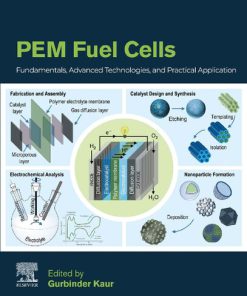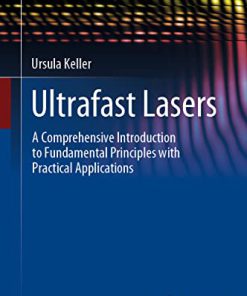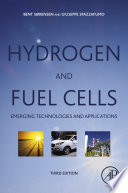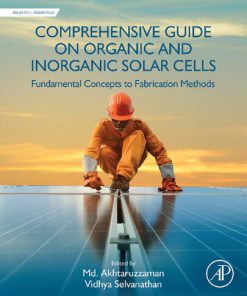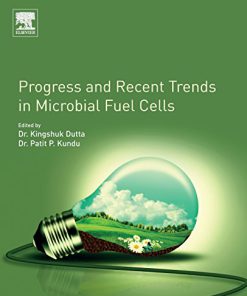Biological Fuel Cells Fundamental to Applications 1st Edition by Mostafa Rahimnejad 0323857116 9780323857116
$50.00 Original price was: $50.00.$25.00Current price is: $25.00.
Biological Fuel Cells Fundamental to Applications 1st Edition by Mostafa Rahimnejad – Ebook PDF Instant Download/Delivery: 0323857116, 9780323857116
Full download Biological Fuel Cells Fundamental to Applications 1st Edition after payment

Product details:
ISBN 10: 0323857116
ISBN 13: 9780323857116
Author: Mostafa Rahimnejad
Biological Fuel Cells: Fundamental to Applications offers a comprehensive update on the latest microbial fuel cells technologies and their systems development and implementation. Taking a practical approach to MFCs, the book provides guidance on analytical methods and tools, economic and performance analyses of various technologies and systems, and engineering aspects. Established and newly developed technologies are presented alongside their applications within the context of cost, practicality and future technologies, which are discussed within the context of other renewable energy systems. This book is a comprehensive reference for users working in the field of fuel cells, microbial fuel cells and bioenergy.
- Presents lab-scale case studies and real-world application on microbial fuel cells
- Provides the fundamental theories and concepts behind MFCs, along with the latest technologies
- Offers guidance on economic and cost analyses for technologies and systems within each chapter
Biological Fuel Cells Fundamental to Applications 1st Table of contents:
Part 1: Constituents, structure, materials and measurement with conceptual, practical and economical views
Chapter 1: Introduction to biological fuel cell technology
Abstract
1.1: Background
1.2: Basic principles
1.3: Potential feedstocks for MFCs
1.4: BFC’s classification
1.5: Conclusions
References
Chapter 2: Microbiological concepts of MFCs
Abstract
2.1: Introduction
2.2: Exoelectrogenic microorganisms
2.3: Electrotrophic microorganisms
2.4: Electron transport mechanisms
2.5: Factors affecting the electron transfer mechanism
2.6: Mechanism of biofilm formation in MFCs
2.7: Factors affecting biofilm formation and performance
2.8: Genetic approaches for improving the performance of MFCs
2.9: Conclusions
References
Chapter 3: Anode electrodes in MFCs
Abstract
3.1: Introduction
3.2: Necessities of anode materials
3.3: Anolytes
3.4: Anode-assisted electrochemical catalysis
3.5: Anode materials
3.6: Surface modification of MFC anode materials
3.7: Conclusions
References
Chapter 4: Cathode electrodes in MFCs
Abstract
4.1: Introduction
4.2: Cathode concepts
4.3: Cathodic structures in MFC
4.4: Cathode requirements in MFCs
4.5: Cathodic surface treatment
4.6: Catholytes
4.7: Enzyme immobilization methods for biocathodes
4.8: Cathode catalysts: Conventional, photo, and biocatalysts
4.9: Conclusions
References
Chapter 5: Energy and power measurement methods in MFCs
Abstract
5.1: Introduction
5.2: Power indicators
5.3: Electrochemical methods
5.4: Biofilm characterization methods
5.5: Conclusions
References
Chapter 6: MFC designing and performance
Abstract
6.1: Introduction
6.2: MFC configurations
6.3: Different modes of operation in MFCs
6.4: Kinetic analysis and modeling of MFCs
6.5: MFCs at a larger laboratory scale
6.6: Pilot-scale MFC designs
6.7: Conclusions
References
Chapter 7: Separators and membranes
Abstract
7.1: Introduction
7.2: Membrane types for MFCs
7.3: Membrane requirements in MFCs
7.4: Conclusions
References
Chapter 8: Supercapacitive microbial fuel cells
Abstract
8.1: Introduction
8.2: High surface area capacitive electrodes in MFCs
8.3: Supercapacitive microbial fuel cells
8.4: Pseudocapacitive MFC electrodes
8.5: Conclusions
References
Chapter 9: MFCs’ challenges and their potential solutions
Abstract
9.1: Introduction
9.2: Voltage losses
9.3: How can biofilm formation cause voltage losses?
9.4: Biofouling formation principles
9.5: Biofouling development on membrane and cathode surfaces
9.6: Biofouling assessment methods
9.7: Driving factors of biofouling
9.8: How to overcome fouling challenges
9.9: Conclusions
References
Chapter 10: MFCs’ commercialization and economic analysis
Abstract
10.1: Introduction
10.2: Field trials of MFCs
10.3: Cost-effective MFC resources
10.4: Commercialization requirements
10.5: Large-scale implementation
10.6: Conclusions
References
Part 2: MFCs’ applications
CHapter 11: Electricity generation
Abstract
11.1: Introduction
11.2: Bioelectricity generation in MFC systems
11.3: Power generation in EFC systems
11.4: Practical implementation of MFC technology for power generation
11.5: Conclusions
References
Chapter 12: Application of biological fuel cell in wastewater treatment
Abstract
12.1: MFCs vs other available options
12.2: Principles of wastewater treatment via MFCs
12.3: Preference of MFCs vs other WWTP
12.4: Expansion of microbial fuel cell research in wastewater treatment
12.5: Mechanisms and reactions of MFC
12.6: Microbial communities for bioanode
12.7: Application of microbial fuel cells in various wastewater treatments
12.8: MFC Integration with other processes in wastewater treatment plants
12.9: Integration of MFC with electro-Fenton technology (BEF)
12.10: Future perspective
12.11: Conclusions
References
Chapter 13: Biohydrogen generation and MECs
Abstract
13.1: Introduction
13.2: MEC fundamentals
13.3: Theoretical yields of MEC systems
13.4: MEC Challenges and promising solutions
13.5: MEC operation
13.6: MEC Performance
13.7: Conclusions
References
Chapter 14: CO2 reduction and MES
Abstract
14.1: Introduction
14.2: Basic principles of MECs utilized for CO2 capture
14.3: MES microbial community
14.4: MES products
14.5: Requirements for MES operation
14.6: MES scale-up
14.7: Conclusions
References
Chapter 15: Bioremediation by MFC technology
Abstract
15.1: Types of microbial fuel cells for bioremediation of pollutants
15.2: Applications of MFC for sludge remediation
15.3: Bioremediation of chromium released from industrial wastewater using MFC
15.4: Bioremediation of landfill leachates and municipal wastewater via MFC
15.5: MFC-assisted biodegradation of azo dyes
15.6: Bioremediation of hydrocarbons and their derivatives
15.7: Removal of heavy metals
15.8: Mechanism and thermodynamic of metal bioelectrodeposition
15.9: Removal of other pollutants
References
Chapter 16: MFC-based biosensors
Abstract
16.1: Measurement and sensors
16.2: Types of sensors
16.3: Recognition element
16.4: Transducer
16.5: Classification of chemical sensors
16.6: Biosensors and their classification
16.7: Biosensors applications
16.8: Self-powered biosensors
16.9: MFC-based biosensors
16.10: Conclusions
References
Chapter 17: Sediment microbial fuel cell (SMFCs)
Abstract
17.1: SMFCs and constructed wetland (CW) associated with it
17.2: Photosynthetic sediment microbial fuel cells (PSMFCs)
17.3: SMFCs and removal of heavy metals
References
Chapter 18: Future applications of biological fuel cells
Abstract
Acknowledgment
18.1: Introduction
18.2: Robotics
18.3: Powering low-energy devices
18.4: MFCs powering remote sensors
18.5: Paper-based MFC devices
18.6: Urine-based MFC
18.7: Concluding remarks
People also search for Biological Fuel Cells Fundamental to Applications 1st:
2 bio
yeast cells function
2 gallon fuel cell
biology 1
Tags:
Mostafa Rahimnejad,Biological,Fundamental,Applications
You may also like…
Physics - Solid State Physics
Uncategorized
Technique - Energy: Renewable Energy
Hydrogen and Fuel Cells Emerging Technologies and Applications 3rd Edition Bent Sørensen
Engineering - Industrial Engineering & Materials Science
Engineering - Chemical Engineering
Progress and Recent Trends in Microbial Fuel Cells 1st Edition Patit Paban Kundu
Engineering - Energy & Power Resources
Engineering - Energy & Power Resources
Introduction to Transfer Phenomena in PEM Fuel Cells 1st Edition Bilal Abderezzak
Biology and other natural sciences - Biotechnology



